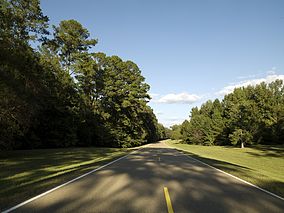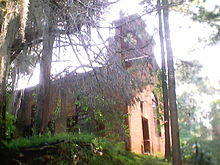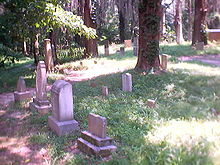- Natchez Trace Parkway
-
Natchez Trace Parkway 
Location Mississippi, Alabama, and Tennessee, USA Nearest city Jackson, Mississippi Area 51,984 acres (210.37 km²) Established May 8, 1938 Visitors 5,482,282 (in 2005) Governing body National Park Service The Natchez Trace Parkway is a National Park Service unit in the southeastern United States that commemorates the historic Old Natchez Trace and preserves sections of the original trail.
 The Natchez Trace Parkway logo can be seen on signs and trail markings along the parkway.
The Natchez Trace Parkway logo can be seen on signs and trail markings along the parkway.
Its central feature is a two-lane parkway road that extends 444 miles (715 km) from Natchez, Mississippi to Nashville, Tennessee. Access to the parkway is limited, with more than 50 access points in the states of Mississippi, Alabama, and Tennessee. The southern end of the route is in Natchez at an intersection with Liberty Road, and the northern end is northeast of Fairview, Tennessee, in the suburban community of Pasquo, Tennessee, at an intersection with Tennessee 100. In addition to Natchez and Nashville, the larger cities along the route include Jackson and Tupelo, Mississippi, and Florence, Alabama.[1][2]
The road is maintained by the National Park Service, and has been designated an All-American Road.
Contents
History
Construction was begun by the federal government in the 1930s. For many years in the later 20th century, most of the trace had been complete, but owing to a lack of funds, two gaps remained, especially one, a several miles long bypass of Jackson, Mississippi. These final two segments, between Interstate 55 and Interstate 20 (in Ridgeland and Clinton, Mississippi, respectively); and between Liberty Road in the city of Natchez, Mississippi and U.S. Highway 61 near Washington, Mississippi, were finally completed and opened on May 21, 2005. The All-American Road is maintained by the National Park Service, to commemorate the original route of the Natchez Trace.
Footpath
The gentle sloping and curving alignment of the current route closely follows the original passage. Its design harkens back to the way the original interweaving trails aligned as an ancient salt-lick-to-grazing-pasture migratory route of the American Bison and other game that moved between grazing the pastures of central and western Mississippi and the salt and other mineral surface deposits of the Cumberland Plateau. The route generally traverses the tops of the low hills and ridges of the watershed divides from northeast to southwest.
Native Americans, following the "traces" of bison and other game, further improved this "walking trail" for foot-borne commerce between major villages located in middle Mississippi and central Tennessee. The route is locally circuitous. However, by traversing this route the bison, and later humans, avoided the endless, energy-taxing climbing and descending of the many hills along the way. Also avoided was the danger to a herd (or groups of human travelers) of being caught en-masse at the bottom of a hollow or valley if attacked by predators. The nature of the route, to this day, affords good all-around visibility for those who travel it.
By the time of European exploration and settlement, the route had become well known and established as the fastest means of communication between the Cumberland Plateau, the Mississippi River, and the Gulf of Mexico settlements of Pensacola, Mobile, and New Orleans. In the early post-Revolutionary War period of America's (south) westward expansion, the Trace was the return route for American flat-boat commerce between the territories of the upper and lower Ohio, Tennessee, and Cumberland River valleys. The Americans would construct flat-boats, load their commerce therein, and drift upon those rivers, one-way south-southwestward all the way to New Orleans, Louisiana. They would then sell their goods (including the salvageable logs of the flat-boats), and return home via the Trace (for the middle section of their return trip), to as far away as Pittsburgh, Pennsylvania.
Improved communications (steam boats, stagecoach lines, and railroads) and the development of ports along the rivers named above, (e.g., Natchez, Memphis, Tennessee, Paducah, Kentucky, Nashville, Tennessee, and Louisville, Kentucky) made the route obsolete as a means of passenger and freight commerce. As a result, no major population centers were born or developed along the Trace, because of its alignment, between its termini Nashville and Natchez. The two cities of note, near or on the Trace's alignment (Jackson, Mississippi and Tupelo, Mississippi), developed only as a result of their alignment along axis of communication different from the Trace. To this day has there has not been constructed a dedicated rail alignment between Natchez and Nashville, even though the Trace's alignment would be the shortest distance between the two cities.
Thus the Trace and its alignment come down to us today almost completely undeveloped and unspoiled along its whole route. Many sections of the original footpath are visible today for observing and hiking the Parkway's right-of-way.
Civilian Conservation Corps
The development of the modern roadway was one of the many projects of the Civilian Conservation Corps during the Great Depression. The road was the proposal of U.S. Congressman T. Jeff Busby of Mississippi, who proposed it as a way to give tribute to the original Natchez Trace. Inspired by the proposal, the Daughters of the American Revolution began planting markers and monuments along the Trace. In 1934, the Franklin Delano Roosevelt administration ordered a survey. President Roosevelt signed the legislation to create the parkway on May 18, 1938.[3] Construction on the Parkway began in 1939, and the route was to be overseen by the National Park Service. Its length includes more than 45,000 acres (182 km²) and the towering Natchez Trace Parkway Bridge in Williamson County, Tennessee, completed in 1994 and one of only two post-tensioned, segmental concrete arch bridges in the world. (See the Federal Highway Administration's photo.)
Historical sites on the Natchez Trace Parkway
There are numerous historical sites on the Parkway, including the Meriwether Lewis Museum, the refurbished Mount Locust stand, and the Mississippi Craft Center in Ridgeland, Mississippi, which focuses on promoting Mississippi's native art. Nestled between the Parkway and Old Port Gibson Road is the ghost town of Rocky Springs that thrived in the late 19th century. Today the old Rocky Springs Methodist Church, the cemetery and several building sites still exist and are accessible from the Parkway. Scenic Cypress Swamp is located at Mile Post 122. There are also several cascading waterfalls to view; for access, some require a bit of hiking from the parkway. In addition, parts of the original trail are still accessible. The history of the Parkway and that of the entire Trace is summarized at the Natchez Trace Visitor Center in Tupelo, Mississippi.
Emerald Mound, the second largest Native American ceremonial mound in the United States is located just west of the Trace and north of Hiway 61 near Natchez. It offers a unique look at the ingenuity and industry of native culture. Two smaller mounds rise from the top of the main mound and rise above treetops offering a wide view. Travelers can reach Emerald Mound with a five minute detour from the main trace hiway. Emerald Mound measures 770 feet (230 m) by 435 feet (133 m) at the base and is 35 feet (11 m) in height. The mound was built by depositing earth along the sides of a natural hill, thus reshaping it and creating an enormous artificial plateau.
Commercial traffic is prohibited along the entire route, and the speed limit is 50 miles per hour (80 km/h). See also the entry titled "Natchez Trace."
Emergency Appropriations Act of June 19, 1934, allocated initial construction funds; established as parkway under National Park Service by act of May 18, 1938.
The Ackia Battleground National Monument (established August 27, 1935, and now called Chickasaw Village) and Meriwether Lewis Park (proclaimed as Meriwether Lewis National Monument February 6, 1925 and transferred from the War Department August 10, 1933) were added to the parkway by act of August 10, 1961.
Total area of the Parkway is 51,746.50 acres (209.41 km², of which 51,680.64 acres (209.14 km²) are federal, and 65.86 acres (0.27 km²) nonfederal. The parkway headquarters is in Tupelo. The parkway also manages two battlefields: Tupelo National Battlefield and Brices Cross Roads National Battlefield Site. The parkway has nine district offices: Leipers Fork, Meriwether Lewis, Cherokee, Tupelo, Dancy, Kosciusko, Ridgeland, Port Gibson and Natchez.[3]
See also
References
- ^ The National Parks: Index 2001-2003. Washington: U.S. Department of the Interior
- ^ National Park Service, Natchez Trace Parkway Fact Sheet, February 25, 2010
- ^ a b "Distribution of Administrative History, Natchez Trace Parkway" (Scanned into Adobe Acrobat (PDF)). National Park Service. pp. 177. http://www.nps.gov/history/history/online_books/natr/adhi.pdf. Retrieved 2007-08-10.
External links
- National Park Service: Natchez Trace Parkway
- The Natchez Trace Compact
- Guide to records (general administrative files) of Natchez Trace National Parkway
Protected Areas of Alabama Federal Bon Secour • Cahaba River • Choctaw • Eufaula • Fern Cave • Key Cave • Mountain Longleaf • Santa Cave • Watercress Darter • Wheeler
Wilderness AreasState Bladon Springs • Blue Springs • Buck's Pocket • Cathedral Caverns • Chattahoochee • Cheaha • Chewacla • Chickasaw • DeSoto • Florala • Frank Jackson • Gulf • Joe Wheeler • Lake Guntersville • Lake Lurleen • Lakepoint • Meaher • Monte Sano • Oak Mountain • Paul M. Grist • Rickwood Caverns • Roland Cooper • Wind Creek
Fayette • Geneva • Little River • Saint Stephens • Weogufka
Alabama Department of Conservation and Natural Resources (web) Federal Bogue Chitto • Coldwater River • Dahomey • Grand Bay • Hillside • Holt Collier • Mathews Brake • Mississippi Sandhill Crane • Morgan Brake • Noxubee • Panther Swamp • St. Catherine Creek • Tallahatchie • Theodore Roosevelt • YazooState Buccaneer • Clark Creek Natural Area • Clarkco • Florewood • George P. Cossar • Golden Memorial • Grand Gulf Military State Park • Great River Road • Holmes County • Hugh White • John W. Kyle • J. P. Coleman • Lake Lincoln • Lake Lowndes • LeFleur's Bluff • Legion • Leroy Percy • Natchez • Paul B. Johnson • Percy Quin • Roosevelt • Shepard • Tishomingo • Tombigbee • Trace • Wall Doxey
Mississippi Department of Wildlife, Fisheries and Parks (web) Categories:- All-American Roads
- Natchez Trace
- United States federal parkways
- Forest Service Byways
- United States National Park Service areas in Alabama
- United States National Park Service areas in Tennessee
- United States National Park Service areas in Mississippi
- Civilian Conservation Corps in Tennessee
- Civilian Conservation Corps in Mississippi
- Civilian Conservation Corps in Alabama
- Protected areas of Adams County, Mississippi
- Protected areas of Davidson County, Tennessee
- Protected areas of Lee County, Mississippi
- Protected areas of Hinds County, Mississippi
- Tupelo, Mississippi
- Protected areas of Madison County, Mississippi
- Protected areas of Attala County, Mississippi
- Protected areas of Chickasaw County, Mississippi
- Protected areas of Choctaw County, Mississippi
- Protected areas of Itawamba County, Mississippi
- Protected areas of Jefferson County, Mississippi
- Protected areas of Pontotoc County, Mississippi
- Protected areas of Tishomingo County, Mississippi
- Protected areas of Colbert County, Alabama
- Protected areas of Wayne County, Tennessee
- Protected areas of Lewis County, Tennessee
- Protected areas of Sevier County, Tennessee
- Protected areas of Williamson County, Tennessee
Wikimedia Foundation. 2010.







